Hair, Makeup and a Little Hollywood Magic Transformed Ana de Armas Into Marilyn Monroe for 'Blonde'
- Oops!Something went wrong.Please try again later.
Despite the film's many controversies, there's no denying the talent — and massive undertaking — of the beauty teams who re-created the iconic signatures with which we're all so familiar.
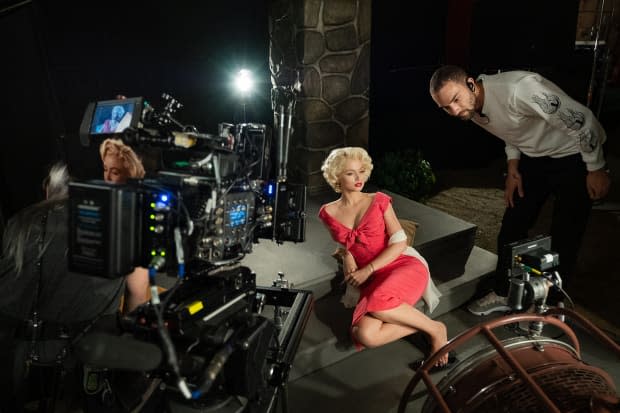
Photo: Matt Kennedy/Courtesy of Netflix
Transforming an actor into a historical figure is never easy, especially when that figure has a face as recognizable and iconic as Marilyn Monroe's.
"Blonde," the much-buzzed-about film that made its Netflix debut on Wednesday, portrays a fictionalized version of Monroe's life, death and transformation from Norma Jeane Mortenson into celebrity and cultural sensation. Director Andrew Dominik (who is himself quite problematic) toys with the tools of film to portray a story of childhood trauma, womanhood and ultimate tragedy.
A whopping heap of controversy precedes the film and how it portrays Monroe: Critics point out the selective storytelling skewed toward victimhood, liberties taken with rumors about the subject's life, graphic assault scenes and an overall sense of exploitation and even torture porn that permeate the film. It's been described as brutal, relentless and generally unnecessary.
"I can hardly recall a moviegoing experience that I so desperately wanted to hit the eject button on by the midway point, yet was so grasped by the throat despite the deterrence," wrote Jack King in a review of the film for GQ.
Based on a novel by Joyce Carol Oates, the film is not (and does not claim to be) a biopic. But for a movie that aims to explore the suffering of an icon, the film perpetuates it. For many viewers, "Blonde" leans into victimization and pity in turn stripping away Monroe's power and career accomplishments. The focus seems to be on trauma — with a gratuitous number of topless scenes.
But despite those controversies, there's no denying the talent — and massive undertaking — of the beauty teams who re-created the iconic signatures with which we're all so familiar. Monroe is, of course, instantly recognizable for her trademark bright blonde hair, cat eyes accentuated by corner lashes and a vibrant red lip. The work and creative vision of makeup artist Tina Roesler Kerwin and hairstylist Jaime Leigh McIntosh brought realism to the film's visuals, transforming de Armas into one of Hollywood's favorite icons with an accuracy that is both remarkable and uncanny.
"One of the things director Andrew Domink had said to me specifically is I can't put Marilyn's makeup on Ana — I have to transform Ana into Marilyn," Kerwin says.
Every cutout and poster of Monroe in the film (and there are many) was recreated with de Armas, meticulously mimicking Monroe's actual looks from decades ago. "There was no cheating," McIntosh says. "There was no superimposing of Ana's face onto already existing images of Marilyn," nor any "photoshopped magic."
This is how they did it.
Makeup as a Vehicle of Transformation for Ana de Armas
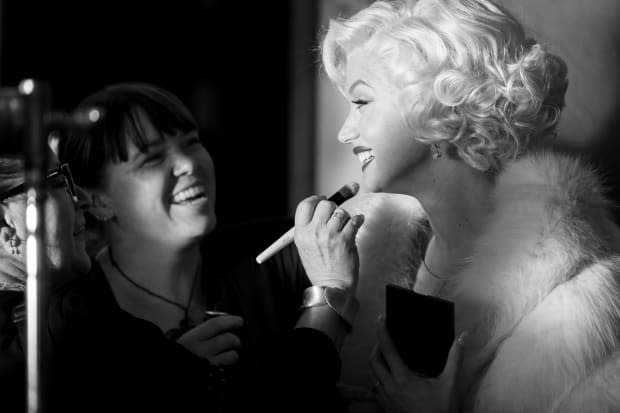
Photo: Matt Kennedy/Courtesy of Netflix
There were a handful of milestones in de Armas' visual transformation, according to Kerwin. They included finding the right foundation, realizing the perfect placement of lashes to mimic Monroe's look and creating authentic aging.
"When I found Charlotte Tilbury Hollywood Flawless Filter Foundation, it gave the reflection and the glow that looks so much like Marilyn's images, because Marilyn used to put Vaseline on her face to create this glow," Kerwin says. "Obviously, I'm not going to put that on [Ana's] face for 16-hour days."
After nailing the complexion and the lash placement, there was the final — and arguably most important — quest: the red lip.
"Blonde" isn't a black-and-white film or a color film. It's both, which means colors need to be consistent across differently colored shots in the movie. This complicates things like lipstick, which can be a vibrant red when in color, but a vampy dark hue when in black and white.
"I had a zillion lipsticks, I mean… gobs of them," Kerwin says. Her favorites became a couple shades from Bésame and Guerlain. Of the 20-plus lip colors Kerwin had on set, she says "some of them worked and some of them didn't work on Ana."
Perhaps the least glamorous makeup of all was the odd liquid that mimics aging: Bluebird FX.
Because the film portrays the life of Monroe from early on through the end of her life at 36 years old, Kerwin needed to authentically age de Armas to look the part. She would stretch de Armas's skin, apply the Bluebird liquid and release her skin after it dried. This created the subtle wrinkles and freckles in the film that feel natural and realistic.
Prosthetics and Three Blonde Wigs Proved Crucial to Re-Creating Monroe's Hair
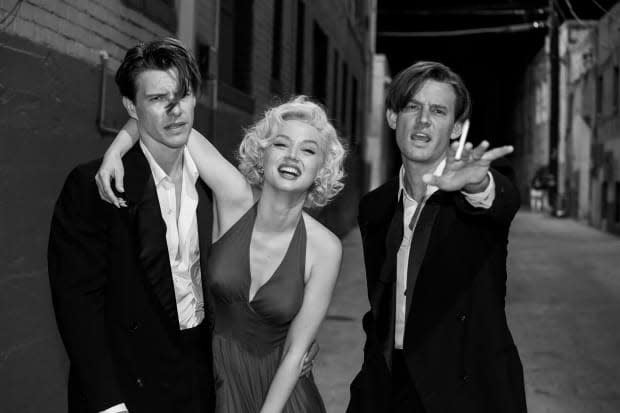
Photo: Courtesy of Netflix
Rather surprisingly, only three blonde wigs are used throughout the entire film.
"Probably one of the biggest challenges was Andrew [Dominik] showing me all these reference pictures that he wanted to recreate and me going, 'But her hair is so short, and this one is so much longer. It's a different blonde here, here and here'," McIntosh recalls.
There would be shots where Monroe's hair would be far shorter than any wig available, but McIntosh says she wouldn't want to pin up the hair to make it look like a helmet and lose movement.
"It was just finding those little compromises and balances," McIntosh says. According to the hairstylist, a bit of TreSemmé Tres Two Unscented Extra Hold Hair Spray went a long way in giving each of the three wigs' versatility.
McIntosh and the rest of the hair team also faced an unexpected challenge with the wigs: the scalp problem. A blonde wig placed over de Armas' dark brown hair would look foolishly obvious. An epiphany came when McIntosh decided to use prosthetics to form a partial bald cap that served as an artificial — but natural-looking — scalp atop de Armas' actual scalp. This way, McIntosh could apply the blonde wigs and nail the appearance of Monroe's hair, down to her widow's peak.
The Beauty Symbolism in 'Blonde'
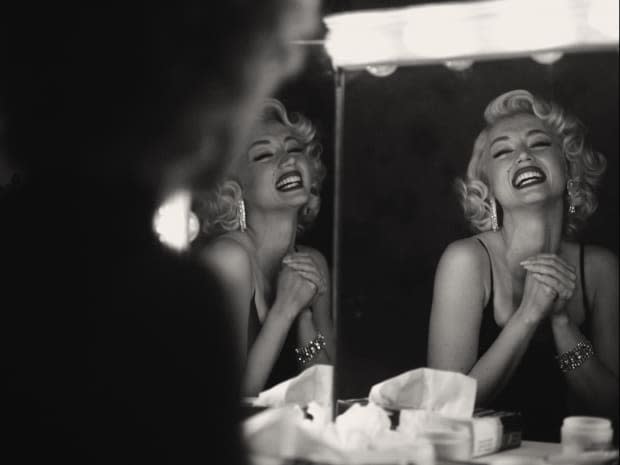
Photo: Courtesy of Netflix
In a film that depicts the complicated duality of Norma Jeane and the adored character she created, Marilyn Monroe, teams behind the scenes experienced their own struggle between choices.
"Especially with a script like this and a story like this, I'm just always aiming and trying and working towards it looking as real as possible," McIntosh says. "Even when it is super glamorous and beautiful-looking, I still want there to be a realness to it."
Some challenges turned into symbolism.
In the scene, for example, in which Monroe is riding in the back of a car with the Secret Service, her hair appears blown out by sunshine streaming in from behind the car. Though the hairstylist found this to be less than ideal while filming, the shot it created also wound up creating space for symbolism. In the final scene, there's a halo effect around Monroe's character during a point in the film where she spirals in a search of affection.
In another scene, one that is featured in trailers and may become the film's most memorable, Norma Jeane sits broken and tearful in front of a mirror, begging for Marilyn to "come out." With the camera spinning around the character, de Armas' ability to change the micro-muscles of her face to mimic Monroe's reveal is astonishing. She goes from deeply somber tears to a radiantly smiling, glammed-up woman. Part of this shift includes subtle changes in hair and makeup.
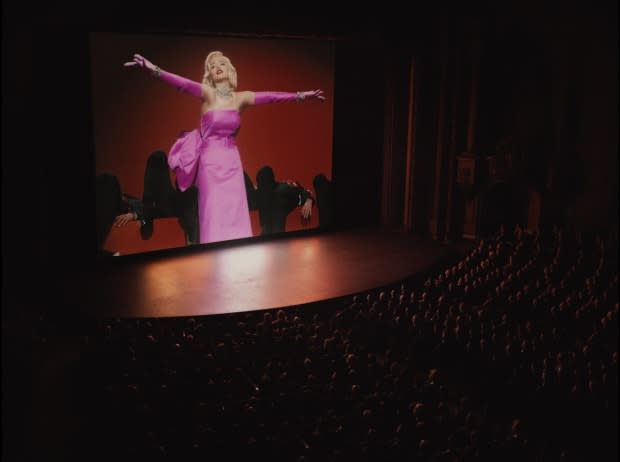
Photo: Courtesy of Netflix
While shooting this scene, Kerwin says there were only 10 minutes to change out the wig, apply new lashes, touch up the makeup and slick on lipstick. "It was one of the insanities of the whole shoot… Because we literally shot her on the bed, she scoots up, we shoot part of that… and then, hair! Wig! Clothes!" Kerwin remembers. "Try gluing lashes on an eye that's full of tears!"
"Ana just does this flip that she's so incredibly good at and just became and embodied Marilyn. And it was amazing to watch," Kerwin says. "We were still off camera catching our breath. It's incredible to watch her do that."
Please note: Occasionally, we use affiliate links on our site. This in no way affects our editorial decision-making.
Never miss the latest fashion industry news. Sign up for the Fashionista daily newsletter.
